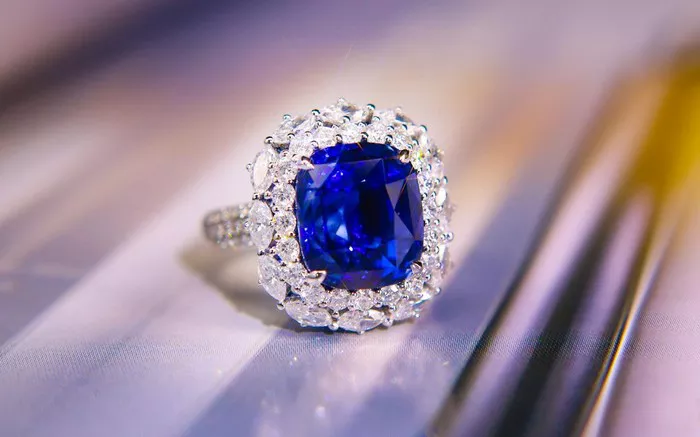Tanzanite, derived from Tanzania in East Africa, is a rare and highly valued gemstone in the jewelry world. It belongs to the zoisite mineral family and is renowned for its striking violet-to-blue hues, which can exhibit a mesmerizing color change depending on lighting conditions. This unique color-changing property, combined with its scarcity, has made tanzanite a popular choice for high-end jewelry, particularly engagement rings.
The Properties of Tanzanite
1. Color and Clarity
Tanzanite’s most captivating feature is its color. Its hues range from a soft, lavender-like violet to a deep, royal blue, often displaying a gradient within a single stone. This color shift is caused by the stone’s pleochroism, meaning it absorbs light differently depending on its crystal orientation.
Clarity is another crucial aspect of tanzanite quality. Like many gemstones, tanzanite can contain inclusions or imperfections. However, the most desirable stones are those with high clarity, showing minimal to no inclusions. High-clarity tanzanite is rare and, therefore, more valuable.
2. Hardness and Durability
Tanzanite has a hardness rating of 6.5 to 7 on the Mohs scale, which is comparable to some other popular gemstones like sapphire (9) and emerald (7.5 to 8). While it is not as hard as some of its counterparts, tanzanite is still durable enough for everyday wear, especially when set in protective settings like prong or bezel settings.
It’s worth noting that tanzanite’s hardness means it can scratch or chip if subjected to rough treatment or harsh chemicals. Proper care and maintenance are essential to preserve its beauty and value.
3. Treatments and Origins
Almost all tanzanite on the market undergoes heat treatment to enhance its color. This process is permanent and is considered standard in the industry. Untreated tanzanite is rare and usually lacks the vibrant color that treated stones exhibit.
As for its origin, tanzanite is exclusively mined in the Merelani Hills of Tanzania’s Manyara Region. This limited source contributes to its rarity and high value.
The Appeal of Tanzanite Engagement Rings
1. Unique Color
The primary appeal of tanzanite for engagement rings lies in its unique and captivating color. Its rare violet-to-blue hues are not only visually stunning but also symbolize love, loyalty, and wisdom, making it an ideal choice for symbolizing a lifelong commitment.
Moreover, tanzanite’s color change adds an extra layer of intrigue. Depending on the lighting, the stone can appear more violet or blue, giving the ring a dynamic and ever-changing beauty.
2. Rarity and Value
Tanzanite’s scarcity adds to its appeal. Since it is only found in one location in the world, and mining operations are limited, the supply is relatively low. This rarity, combined with its desirability, ensures that tanzanite engagement rings hold their value well over time.
3. Versatility in Design
Tanzanite’s versatility in design also makes it a popular choice for engagement rings. Its color palette complements a wide range of metal settings, from classic white or yellow gold to modern rose gold or platinum.
Additionally, tanzanite can be cut into various shapes, including round, princess, cushion, and emerald cuts. This allows jewelers to create unique and personalized designs that cater to individual tastes and styles.
Practical Considerations for Tanzanite Engagement Rings
1. Care and Maintenance
While tanzanite is durable enough for everyday wear, it requires careful handling and maintenance to retain its beauty. Regular cleaning with a soft cloth and warm water is essential to remove dirt and grime. Avoid exposing tanzanite to harsh chemicals, heat, or abrasive surfaces, which can damage the stone.
Professional cleaning and inspections every six to 12 months are also recommended to ensure the setting is secure and the stone is in good condition.
2. Setting and Protection
To protect tanzanite’s softer hardness, it is crucial to choose a setting that provides adequate protection. Prong settings are a popular choice as they securely hold the stone while allowing light to pass through, enhancing its brilliance.
Bezel settings are another option, providing a more secure option that completely surrounds the gemstone. However, they can obscure some of the stone’s beauty by blocking light.
3. Budget Considerations
While tanzanite engagement rings are highly desirable, they can also be quite costly. The price depends on various factors, including the stone’s size, clarity, color, and cut. Larger, higher-quality stones are more expensive, but even smaller tanzanite pieces can be beautiful and affordable.
It’s important to set a budget before shopping for a tanzanite engagement ring and to remember that quality is more important than size. A well-cut, high-clarity tanzanite stone in a protective setting will look stunning and retain its value over time.
Conclusion
In conclusion, tanzanite is an excellent choice for engagement rings, thanks to its unique color, rarity, and versatility in design. While it requires careful handling and maintenance, its beauty and value make it a worthwhile investment.However, it’s important to consider personal preferences, budget, and lifestyle before making a final decision. With so many gemstone options available, there is sure to be a perfect engagement ring that suits every individual’s taste and needs.Remember, the most important aspect of an engagement ring is its sentimental value and the love it represents. No matter which gemstone you choose, the ring will be a cherished symbol of your commitment and partnership.
Related topic:
- Tanzanite Teardrop Rings: Radiate Style and Sophistication
- Tanzanite Plugs: A Complete Guide to Choosing the Right Pair
- Tanzanite in Titanic: How Kate Winslet Made It a Star Gem


